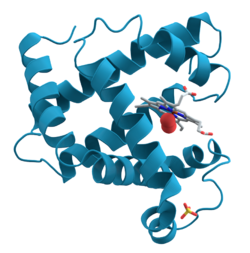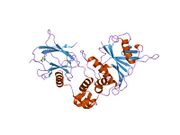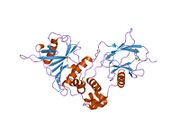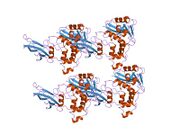Biology:ELOC
 Generic protein structure example |
Elongin C is a protein that in humans is encoded by the ELOC gene.[1][2]
Function
Elongin C is a subunit of the transcription factor B (SIII) complex. The SIII complex is composed of elongins A/A2, B and C. It activates elongation by RNA polymerase II by suppressing transient pausing of the polymerase at many sites within transcription units. Elongin A functions as the transcriptionally active component of the SIII complex, whereas elongins B and C are regulatory subunits. Elongin A2 is specifically expressed in the testis, and capable of forming a stable complex with elongins B and C. The von Hippel-Lindau tumor suppressor protein binds to elongins B and C, and thereby inhibits transcription elongation.[3]
Interactions
TCEB1 has been shown to interact with:
References
- ↑ "A human cDNA encoding the small subunit of RNA polymerase II transcription factor SIII". Gene 150 (2): 413–4. Feb 1995. doi:10.1016/0378-1119(94)90467-7. PMID 7821821.
- ↑ "Inhibition of transcription elongation by the VHL tumor suppressor protein". Science 269 (5229): 1402–6. Oct 1995. doi:10.1126/science.7660122. PMID 7660122. https://zenodo.org/record/1231223.
- ↑ "Entrez Gene: TCEB1 transcription elongation factor B (SIII), polypeptide 1 (15kDa, elongin C)". https://www.ncbi.nlm.nih.gov/sites/entrez?Db=gene&Cmd=ShowDetailView&TermToSearch=6921.
- ↑ "Towards a proteome-scale map of the human protein-protein interaction network". Nature 437 (7062): 1173–8. Oct 2005. doi:10.1038/nature04209. PMID 16189514. Bibcode: 2005Natur.437.1173R.
- ↑ 5.0 5.1 "Synthetic peptides define critical contacts between elongin C, elongin B, and the von Hippel-Lindau protein". J. Clin. Invest. 104 (11): 1583–91. Dec 1999. doi:10.1172/JCI8161. PMID 10587522.
- ↑ "Tumor suppression and transcription elongation: the dire consequences of changing partners". Science 269 (5229): 1400–1. Sep 1995. doi:10.1126/science.7660121. PMID 7660121.
- ↑ 7.0 7.1 "Ubiquitination of a novel deubiquitinating enzyme requires direct binding to von Hippel-Lindau tumor suppressor protein". J. Biol. Chem. 277 (7): 4656–62. Feb 2002. doi:10.1074/jbc.M108269200. PMID 11739384.
- ↑ "Large-scale mapping of human protein-protein interactions by mass spectrometry". Mol. Syst. Biol. 3: 89. 2007. doi:10.1038/msb4100134. PMID 17353931.
- ↑ "Identification of a novel protein (VBP-1) binding to the von Hippel-Lindau (VHL) tumor suppressor gene product". Cancer Res. 56 (13): 2881–5. Jul 1996. PMID 8674032.
- ↑ "Structure of an HIF-1alpha -pVHL complex: hydroxyproline recognition in signaling". Science 296 (5574): 1886–9. Jun 2002. doi:10.1126/science.1073440. PMID 12004076.
- ↑ Zhang, Baohong, ed (2008). "VHL type 2B mutations retain VBC complex form and function". PLOS ONE 3 (11): e3801. doi:10.1371/journal.pone.0003801. PMID 19030229.
- ↑ "Nur77 upregulates HIF-alpha by inhibiting pVHL-mediated degradation". Exp. Mol. Med. 40 (1): 71–83. Feb 2008. doi:10.3858/emm.2008.40.1.71. PMID 18305400.
Further reading
- "Elongin (SIII): a multisubunit regulator of elongation by RNA polymerase II". Science 269 (5229): 1439–43. 1995. doi:10.1126/science.7660129. PMID 7660129.
- "Binding of the von Hippel-Lindau tumor suppressor protein to Elongin B and C". Science 269 (5229): 1444–6. 1995. doi:10.1126/science.7660130. PMID 7660130.
- "RNA polymerase II transcription factor SIII. I. Identification, purification, and properties". J. Biol. Chem. 268 (34): 25587–93. 1994. doi:10.1016/S0021-9258(19)74431-7. PMID 8244996.
- "The von Hippel-Lindau tumor-suppressor gene product forms a stable complex with human CUL-2, a member of the Cdc53 family of proteins". Proc. Natl. Acad. Sci. U.S.A. 94 (6): 2156–61. 1997. doi:10.1073/pnas.94.6.2156. PMID 9122164.
- "Regulation of hypoxia-inducible mRNAs by the von Hippel-Lindau tumor suppressor protein requires binding to complexes containing elongins B/C and Cul2". Mol. Cell. Biol. 18 (2): 732–41. 1998. doi:10.1128/mcb.18.2.732. PMID 9447969.
- "The conserved SOCS box motif in suppressors of cytokine signaling binds to elongins B and C and may couple bound proteins to proteasomal degradation". Proc. Natl. Acad. Sci. U.S.A. 96 (5): 2071–6. 1999. doi:10.1073/pnas.96.5.2071. PMID 10051596.
- "Structure of the VHL-ElonginC-ElonginB complex: implications for VHL tumor suppressor function". Science 284 (5413): 455–61. 1999. doi:10.1126/science.284.5413.455. PMID 10205047.
- "Studying interactions of four proteins in the yeast two-hybrid system: structural resemblance of the pVHL/elongin BC/hCUL-2 complex with the ubiquitin ligase complex SKP1/cullin/F-box protein". Proc. Natl. Acad. Sci. U.S.A. 96 (17): 9533–8. 1999. doi:10.1073/pnas.96.17.9533. PMID 10449727.
- "Identification of the von Hippel-lindau tumor-suppressor protein as part of an active E3 ubiquitin ligase complex". Proc. Natl. Acad. Sci. U.S.A. 96 (22): 12436–41. 1999. doi:10.1073/pnas.96.22.12436. PMID 10535940.
- "Synthetic peptides define critical contacts between elongin C, elongin B, and the von Hippel-Lindau protein". J. Clin. Invest. 104 (11): 1583–91. 2000. doi:10.1172/JCI8161. PMID 10587522.
- "Identification and characterization of Elongin A2, a new member of the Elongin family of transcription elongation factors, specifically expressed in the testis". J. Biol. Chem. 275 (9): 6546–52. 2000. doi:10.1074/jbc.275.9.6546. PMID 10692460.
- "Tracheal development and the von Hippel-Lindau tumor suppressor homolog in Drosophila". Oncogene 19 (24): 2803–11. 2000. doi:10.1038/sj.onc.1203611. PMID 10851083.
- "Activation of HIF1alpha ubiquitination by a reconstituted von Hippel-Lindau (VHL) tumor suppressor complex". Proc. Natl. Acad. Sci. U.S.A. 97 (19): 10430–5. 2000. doi:10.1073/pnas.190332597. PMID 10973499.
- "Drosophila von Hippel-Lindau tumor suppressor complex possesses E3 ubiquitin ligase activity". Biochem. Biophys. Res. Commun. 276 (1): 355–61. 2000. doi:10.1006/bbrc.2000.3451. PMID 11006129.
- "Muf1, a novel Elongin BC-interacting leucine-rich repeat protein that can assemble with Cul5 and Rbx1 to reconstitute a ubiquitin ligase". J. Biol. Chem. 276 (32): 29748–53. 2001. doi:10.1074/jbc.M103093200. PMID 11384984.
- "Ubiquitination of a novel deubiquitinating enzyme requires direct binding to von Hippel-Lindau tumor suppressor protein". J. Biol. Chem. 277 (7): 4656–62. 2002. doi:10.1074/jbc.M108269200. PMID 11739384.
- "Identification and biochemical characterization of a novel transcription elongation factor, Elongin A3". J. Biol. Chem. 277 (29): 26444–51. 2002. doi:10.1074/jbc.M202859200. PMID 11994304.
- "Amplification and overexpression of Elongin C gene discovered in prostate cancer by cDNA microarrays". Lab. Invest. 82 (5): 629–37. 2002. doi:10.1038/labinvest.3780457. PMID 12004003.







